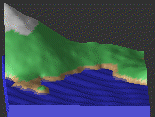
At the start of this project I had no real intention of writting a Data Explorer module. I was simply going to generate C code to output raw data and then use an "Import" module to view the data. I began researching fractal landscapes, and found a few truley excellent books on the topic, with theory, math and (ooh boy!) algorithms.
It seemed to me that the most common landscape algorithm was two dimensional fractal midpoint displacement. The basic theory here is that you start with a flat mesh. You then take a few random points and give them a new "random" height. You then continue this for some set time. The key here however is that the "random" is not truely random but a sort-of fractal random. This is what generates the real landscape look. A truely random displacement would (and does) look like a horrible torture device.
Since I had the algorithm sitting in front of me it took fairly little effort to convert it into a piece of C code. So before long I had a working landscape. However, it had many limitations. It was a pain to have to re-run the C code and generate a new output file each time I wanted to vary the landscape's parameters. I was also locked into one chosen size unless I wanted to vary paremeters in the code and in DX's Import definitions. So I decided to move on and write my own module, that would take care of all of this.
This is where the work came in. Writting a Data Explorer module could be relatively simple (and it is once you've completed). However, it is mostly undocumented and fairly cryptic. So I spent hours churning through other research projects, trying to adapt theirs to mine, trying to figure out why I kept "Disconnecting" from the server (it turned out to be a missing include file). Finally I have what is now a completed DX module, and it does churn out some fairly nice landscapes. Keep in mind it simply takes a plane and deforms it. Any "water levels" or coloring must be done through data explorer itself.
The "results" section of this report is nothing more than a set of neat landscape images that I created in DX. The first one is my pride and joy and shows what can be created with a little effort and DX know how. The second shows what a "plain-vanilla" landscape net outputs. The rest are variations on a theme.
Click on a thumbnail to see the "big" picture.
Using a low "h" value:
Using a high "h" value:
Using a low "sigma" value:
Using a high "sigma" value:


